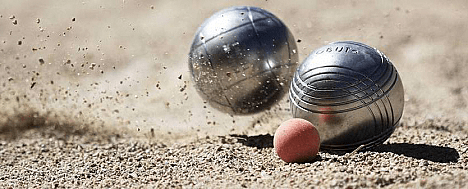History
Launch and spread the game
2022-04-26

Pétanque (French pronunciation: [petɑ̃k] (listen), locally in Provence [peˈtãᵑkə]; Occitan: petanca, [peˈtaŋkɔ] (listen), also Catalan: [pəˈtaŋkə] or [peˈtaŋka]) is a sport that falls into the category of boules sports, along with raffa, bocce, boule lyonnaise, lawn bowls and crown green bowling. In all of these sports, players or teams play their boules/balls towards a target ball.[1]
In pétanque the objective is to score points by having boules closer to the target than the opponent after all boules have been thrown. This is achieved by throwing or rolling boules closer to the small target ball, officially called a jack[2] but known colloquially as a cochonnet,[3] or by hitting the opponents' boules away from the target, while standing inside a circle with both feet on the ground.
The game is normally and best played on hard dirt or gravel. It can be played in public areas in parks or in dedicated facilities called boulodromes.
The current form of the game was codified in 1907 or 1910 in La Ciotat, in Provence, France. The French name pétanque (borrowed into English, with or without the acute accent) comes from petanca in the Provençal dialect of the Occitan language, deriving from the expression pè tancat [ˈpɛ taŋˈkat], meaning 'foot fixed' or 'foot planted' (on the ground).
Invention of the game
Boules games have a very long history, dating back through the Middle Ages to ancient Rome, and before that to ancient Greece and Egypt.
In France in the second half of the 19th century a form of boules known as jeu provençal (or boule lyonnaise) was extremely popular. In this form of the game players rolled their boules or ran three steps before throwing a boule. Pétanque originally developed as an offshoot or variant of jeu provençal in 1910, in what is now called the Jules Lenoir Boulodrome in the town of La Ciotat near Marseilles. A former jeu provençal player named Jules Lenoir was afflicted by rheumatism so severe that he could no longer run before throwing a boule. In fact, he could barely stand. A good friend named Ernest Pitiot was a local café owner. In order to accommodate his friend Lenoir, Pitiot developed a variant form of the game in which the length of the pitch or field was reduced by roughly half, and a player, instead of running to throw a boule, stood, stationary, in a circle. They called the game pieds tanqués, "feet planted" (on the ground), a name that eventually evolved into the game's current name, pétanque.[4]
The first pétanque tournament was organized by Ernest Pitiot, along with his brother Joseph Pitiot, in 1910 in La Ciotat. After that the game spread quickly and soon became the most popular form of boules in France.
Before the mid-1800s, European boules games were played with solid wooden balls, usually made from boxwood root, a very hard wood. The late 1800s saw the introduction of cheap mass-manufactured nails, and wooden boules gradually began to be covered with nails, producing boules cloutées ("nailed boules"). After World War I, cannonball manufacturing technology was adapted to allow the manufacture of hollow, all-metal boules. The first all-metal boule, la Boule Intégrale, was introduced in the mid-1920s by Paul Courtieu. The Intégrale was cast in a single piece from a bronze-aluminum alloy. Shortly thereafter, Jean Blanc invented a process of manufacturing steel boules by stamping two steel blanks into hemispheres and then welding the two hemispheres together to create a boule. With this technological advance, hollow all-metal balls rapidly became the norm.
Global spread of the game
Pétanque being played indoors at an IBA reunion in Rotterdam, the Netherlands
After the development of the all-metal boule, pétanque spread rapidly from Provence to the rest of France, then to the rest of Europe, and then to Francophone colonies and countries around the globe. Today, many countries have their own national governing bodies.
In France, the Fédération Française de Pétanque et Jeu Provençal (FFPJP) has over 300,000 licensed members.
There are strong national federations in Germany, Spain and England. Pétanque is actively played in many nations with histories of French colonial influence, especially in Southeast Asia, including Laos, Thailand, Vietnam, Cambodia and Puducherry in India, as well as some parts of Africa. The sport is also popular in Madagascar and Thailand.
Pétanque was featured at the 2015 All-Africa Games hosted by the Republic of the Congo, a former French colony.[5]
Pétanque is not widely played in the Americas. There is a Canadian pétanque federation based in Québec. In the United States, the Federation of Pétanque USA (FPUSA) reports that about 30,000 play nationwide. As of 1 December 2015, FPUSA counted 2141 members in the US, in 52 affiliated clubs.[6]
On the international level, the governing body of pétanque is the Fédération Internationale de Pétanque et Jeu Provençal (FIPJP). It was founded in 1958 in Marseille and has almost 800,000 members as of 2022.[7]
In popular culture
The game made an appearance in the 1966 French crime film Le deuxieme souffle. Pétanque also appeared in Season 4 Episode 20 (Pétanque) of the American sitcom The Cosby Show in 1988. In the 1981 film adaptation of the Agatha Christie mystery Evil Under The Sun, a suspect played by James Mason is questioned about his alibi while playing a game. The fourth episode of The Amazing Race 30 featured a pétanque competition at Place des Lices in Saint-Tropez.[8] Asterix Versus Caesar features the Gauls playing a pétanque-esque game with rocks.